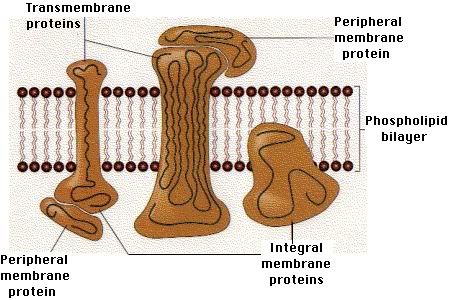
Friday, June 05, 2009
|
|
37th Common
|
|
Join Date: Mar 2006
Posts: 1,514
Thanks: 1,053
Thanked 1,681 Times in 873 Posts
|
|
 Cell Biology Plasma Membrane Part II
Cell Biology Plasma Membrane Part II
Integral Membrane Proteins
Many of the proteins associated with the plasma membrane are tightly bound to it. - Some are attached to lipids in the bilayer.
- In others - the transmembrane proteins - the polypeptide chain actually traverses the lipid bilayer.
- In all these cases, the portion within the lipid bilayer consists primarily of hydrophobic amino acids. These are usually arranged in an alpha helix so that the polar -C=O and -NH groups at the peptide bonds can interact with each other rather than with their hydrophobic surroundings.
Those portions of the polypeptide that project out from the bilayer tend to have a high percentage of hydrophilic amino acids. Furthermore, those that project into the aqueous surroundings of the cell are usually glycoproteins, with many hydrophilic sugar residues attached to the part of the polypeptide exposed at the surface of the cell.
Some transmembrane proteins that span the bilayer several times form a hydrophilic channel through which certain ions and molecules can enter (or leave) the cell.

These are more loosely associated with the membrane. They are usually attached noncovalently to the protruding portions of integral membrane proteins.
Membrane proteins are often restricted in their movements.
A lipid bilayer is really a film of oil. Thus we might expect that structures immersed in it would be relatively free to float about. For some membrane proteins, this is the case. For others, however, their mobility is limited: - Some of the proteins exposed at the interior face of the plasma membrane are tethered to cytoskeletal elements like actin microfilaments.
- Some proteins are the exterior face of the plasma membrane is anchored to components of the extracellular matrix like collagen.
- Integral membrane proteins cannot pass through the tight junctions found between some kinds of cells (e.g., epithelial cells).
Membrane Transport of Small Molecules
Because of the hydrophobic interior of the lipid bilayer, polar molecules cannot enter the cell. However, cells devised means of transferring small polar molecules. Transport proteins, each specialized for a certain molecule, can transport polar molecules across the membrane. There are several types of membrane transport proteins. Uniports simply move solutes from one side to another. Cotransport systems work by simultaneously sending two solutes across the lipid bilayer. There are two types of cotransport systems - symport, in which the solutes are sent in the same direction, or antiport, in which they are sent in opposite directions. These transport proteins work passively, meaning that the cell doesn't have to expend energy sending the solute in or out. This is dependent on the solute moving in its natural direction - i.e. moving from more concentrated solution to less concentrated, or from positive to negative.
Some specific examples of transport membranes are channel proteins, which allow solutes to cross if they are the correct size and charge. Carrier proteins bind to the solute and lead it through the bilayer. These are examples of passive transport. To move a solute against their natural direction - for example higher concentration to lower concentration, energy (ATP) is needed to pump the solute in or out.
An example of active transport is the sodium-potassium pump, which in conjunction with the potassium leak channel allows the cell the control it's membrane potential. The sodium-potassium-ATPase, which uses the energy of ATP hydrolysis, pump pumps sodium out and potassium in, which creates a high concentration of potassium inside the cell, and a low concentration outside. The reverse applies to the sodium. The potassium leak channel allows the potassium to leak out (so to even out the concentrations), which gives the cell and negative charge on the inside.
Membrane Transport of Macromolecules
Most cells use exocytosis and endocytosis to secrete and ingest macromolecules, respectively. In exocytosis the contents of special vesicles are released when the vesicle fuses with the cell membrane. In endocytosis the membrane depresses and pinches off, enclosing the molecule. Two different sizes are formed - pinocytotic (small) and phagocytic (large).
In receptor-mediated endocytosis, coated pits and vesicles bind to specific receptors on the cell surface, allowing the cell to select what molecules to take and what to reject.
Membrane Receptors
The cell membrane is pocketed with receptors and antigens. Molecules targeted toward that specific cell will bind with the cell surface receptor, which binds the signaling molecule and sends a signal that alters the behavior of the target cell. Antigens are used to tell the cell whether foreign materials are present. If any foreign materials are detected the immune system will mobilize its killer T-cells to destroy the foreign cell.
Functions of cell membrane:
1). The cell membrane surrounds the cytoplasm of a cell and, in animal cells, physically separates the intracellular components from the extracellular environment.
2).The cell membrane also plays a role in anchoring the cytoskeleton to provide shape to the cell, and in attaching to the extracellular matrix to help group cells together in the formation of tissues.
3).The barrier is selectively permeable and able to regulate what enters and exits the cell, thus facilitating the transport of materials needed for survival.
4).Specific proteins embedded in the cell membrane can act as molecular signals that allow cells to communicate with each other. Protein receptors are found ubiquitously and function to receive signals from both the environment and other cells.
5). Other proteins on the surface of the cell membrane serve as "markers" that identify a cell to other cells. The interaction of these markers with their respective receptors forms the basis of cell-cell interaction in the immune system.

|